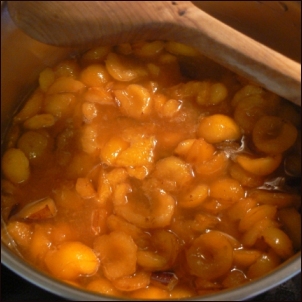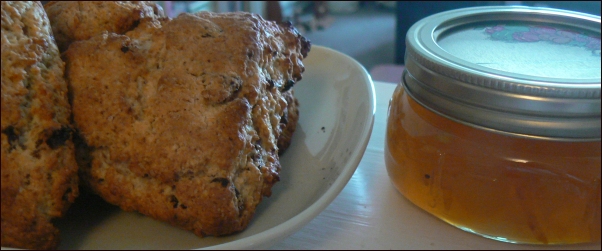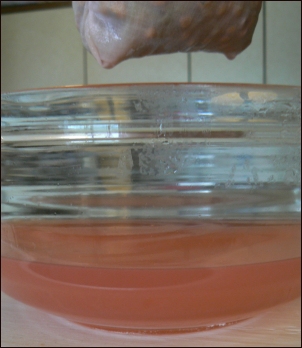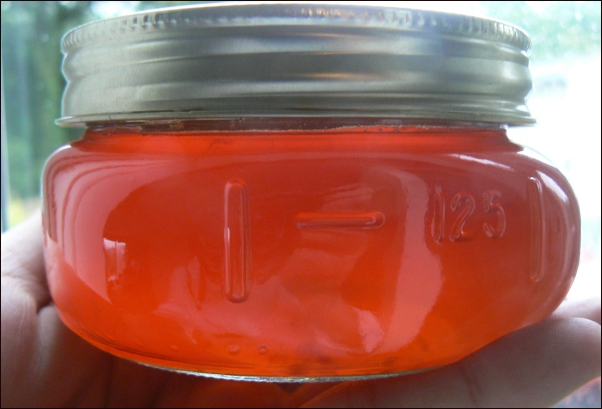
Is it possible to be too fond of a jar of jelly?
Despite the trepidation with which I approached yesterday’s jam session, I am pleased to report that all went well, and we have the jam to show for it. In the face of exploding Jam Myths, I was forced to release the many preconceived ideas I had about making jam, and whether I would be able to do it here in Britain. I used different tools and a slightly different method, in the process figured some stuff out about making jam. And, despite her initial reluctance, Tonia came right around in the end, and made a batch of hedgerow jam all on her own. The result is many glowing jewel-like little pots of the sweet stuff, that I can’t yet bring myself to store away in a cupboard. They are just too pretty to look at.
We began with road side scavenged plums; tiny (about the size of a cherry tomato) and bright yellow. I have no idea what variety they are, but the flesh is sweet, and the skins are tart. Tonia found the tree growing beside a lay-by on the A40, and stopped to harvest them on her way home Friday night. They were a bit ripe and we probably let them sit a day longer than we should have, as we had trouble with the set, despite adding a half a packet of pectin. We didn’t know that when we potted them up, however.
We processed the plums in two batches, in our largest saucepan, and in doing we exploded the first Jam Myth of the day. At some point in my early jam making I was told never to divide a jam recipe; that disaster was sure to follow. Disaster in the form of unset jam, as the proportion of ingredients is key to a successful set. I have carried this as a home truth of jam making ever since, but it’s rubbish. Making the jam in smaller batches works fine. Truly. I suppose it’s a bit more work, cooking two batches instead of one, but if the pan you have is too small, it’s perfectly fine to reduce quantities.
After watching me at the jam pot making the first batch, Tonia took over for the second. This batch was a lot more amber colored than the first and, as we reached the bottom of the pan during the potting up, we discovered why. The bottom of the pot was golden brown with caramelized sugar and bits of stuck-on fruit. Tonia hadn’t stirred the sugar until it was completely dissolved. Thankfully, the sugar hadn’t burned, and the batch was fine. Delicious, in fact, with a hint of caramel flavor to it. And now we know to stir and stir and stir until ALL the sugar has dissolved. The finished jam (which we have dubbed A40 Gold) tastes wonderful, despite the mishap, the tart skins adding just enough of a bite to balance the sweetness.
And therein lies the lesson of Exploding Jam Myth, the second. I’m not sure where I got the idea that jam making had to be consistent, but this is one of my silly jam making notions I’m happy to let go of. Happy accidents are why you make jam at home. If you want jam that always tastes the same, no matter what, you should probably buy it at the supermarket.

With the plums processed we dressed and headed out of the house, buckets in hand, to see what we could score from Millennium Woods. Tonia managed to sleuth out half a kilo of blackberries though it was hard going, as it’s still very early in the season. A few of the crab apple trees yielded fruit that was nearly ripe, and she brought home nearly a kilo of those. My eyes were firmly on the Rowan trees, heavy with berries. They have ripened very early this year, maybe due to all the rain, and I’ve been noticing them over the hedgerow for the last couple of weeks. The birds have already had a lot of the fruit, and those I could get to mostly weren’t very nice. Maddeningly, the best and most perfectly ripe berries were either just out of reach, or hanging on trees way off the path, surrounded by impenetrable carpets of brambles. Still, I managed to gather a half a kilo of just passable berries, enough for a small batch of Crabapple Rowan Jelly.
Back at the house Tonia stemmed the berries, and chopped the fruit, while I scoured the web for alternatives to a store bought jelly bag, and discovered that seasoned jelly makers are fairly scathing about those store bought bags and the tippy three-legged contraptions for catching the liquid from cooked fruit. Apparently an old pillow case is all you need.
 I dug around in the linen cupboard, and found a threadbare pillowcase that I haven’t used in a while, and got busy. I sewed up the sides to narrow the bottom of the case and create a funnel shape, then cut off the open end of the case, and folded it over and sewed a casing, through which I threaded household string. It took all of twenty minutes to come up with this gadget, and it worked beautifully. It took the two of us and a bit of finagling to fill the bag, and hang the bag and position the bowl just so, but we figured it out, and then walked away to let the pink-tinged liquid drip.
I dug around in the linen cupboard, and found a threadbare pillowcase that I haven’t used in a while, and got busy. I sewed up the sides to narrow the bottom of the case and create a funnel shape, then cut off the open end of the case, and folded it over and sewed a casing, through which I threaded household string. It took all of twenty minutes to come up with this gadget, and it worked beautifully. It took the two of us and a bit of finagling to fill the bag, and hang the bag and position the bowl just so, but we figured it out, and then walked away to let the pink-tinged liquid drip.
Tonia turned her attention to the blackberries and crab apples, and quickly turned the fruit into some pretty darned delicious jam, all by herself. This is when we noticed that the plum jam, now nearly cool, hadn’t set. I don’t really mind a soft set jam, in fact, I prefer it to the stuff you can bounce off walls, but this was rather more like syrup. Well, you win some, you lose some. I bemoaned the unset jam on Twitter, and was informed by a kind Jam Fairy that I could dump the jam back into the pot, add more pectin and actually fix it. And there it was. Exploding Jam Myth, the third. Unless it’s burnt, jam mistakes are usually fixable.
Yes, we could have called it “syrup” and used it on pancakes. Yes, it was a bit of a pain in the ass to dump the jam back in the pot, and wash and sterilize the jars and seals all over again. With two of us working together, however, we managed it in short order, as by this point in the afternoon we had become seasoned jam making pros. Another half packet of pectin, a little time on the stove, and our A40 Gold is no longer syrup, but jam.
The final task of the day was the making of the jelly, a whole new thing for me. With the jelly bag no longer dripping, I measured the liquid in the bowl, and added sugar and a half packet of pectin. I probably didn’t need the pectin, as the crab apples are full of the stuff, but after the plum debacle I wasn’t taking any chances. I boiled the syrup down, testing every few minutes for set, and when it was ready I poured it into the waiting jars.
Behold, my first ever jelly. I’m inordinately proud of this jelly.The Rowan berries give it a gorgeous rosy pink hue, and a slightly bitter taste, which is similar in many ways to marmalade. It’s not the kind of jelly you want to spread on toast, but I imagine served with pork or chicken this autumn, it’ll be wonderful.


hurrah! Welcome to jam-making British style! I love the journey, it’s always exciting because you never know where you are going to end up!
I was grinning madly all through reading this post. As knit nurse said, welcome to jam-making, not only British style but – as it seams, European style. You jam and jelly look marvelous.
Oh, such lovely jars! I’m not surprised you can’t bring yourself to put them away just now.
Crabapple jelly? I have two giant, fruit-laden crabapple trees in my garden and would love to know where to find a recipe for jelly! I loved your jam commentary….great job!
Seems like you found yourself a mirabelle plum tree. What a delicious blog entry! And what fun I had listening through all the make do and mend series. Thanks a million, Brenda!
If you have this problem with setting again try lemon juice instead of the pectin. If you are making jelly you can throw the skins and everything in. I hadn’t realised that we made jam differently until I talked to Jo Brown an American member of our sn’b. Did you bring the kilner jars with you? I use recycled jam jars but Jo is a bit worried about this. The jam looks wonderful and is making my mouth water, I’m making plum jam tomorrow D
GLORIOUS!! You’re inspiring…..Now where DID I put that jalapeno-cranberry jelly recipe???
Oh, and my favorite of all food writers, the late Laurie Colwin (lovely British writer!!) published a DIVINE lemon chutney recipe in one of her books..lemon pith and peel like marmelade, with brown sugar, raising, almonds, onions, etc….yummy yummy yummy–and it’s better if it sits for 6 months…..if you like chutneys, I would be happy to share it….come to think of it , I need to make a batch………
ooh, how about the Rowan jelly over some cream cheese or a port-wine soft cheese as a party spread or appetizer with water crackers? Or is that too American????
I agree with Lies – if your small yellow plums are egg-shaped they are almost definitely Mirabelles, a type of bullace. I made the most fabulous Mirabelle jam last weekend from a tree that cropped for the first time in living memory! I used 50:50 granulated sugar:jam sugar as the plums are medium in both pectin and acid content and the set was perfect. We also have two cherry plum trees on the farm and this year I made jam and chutney from a bumper crop – these plums are Myrobalans which have small, round, red or yellow fruits.
The RHS gives advice on how to differentiate between the various wild plum-like fruit in the UK: http://www.rhs.org.uk/advice/profiles0707/plumtypes.asp – no photographs unfortunately.
A few jam-making hints that work for me:
1. It’s a good idea to simmer plums they are softened before adding the sugar as the sugars adding sugar at the start tends to make the skins a little tough.
2. The sugar should either be warmed in a low oven (bottom oven of an Aga) or stirred into the fruit on a low heat so that it dissolves quickly.
3. As fruit ripens the levels of pectin and acid decrease – if using mostly ripe/over-ripe fruit just add a few that are under-ripe.
4. I always subject my jams to a water bath to increase their shelf life – fingertip tighten the lids and submerge in boiling water for 10 mins before removing. Tighten the lids more firmly and leave to cool. Always use a folded teatowel at the bottom of the pan you’re using for the water bath to prevent the jars cracking.
Elizabeth – I’ve never heard of lemon chutney and would LOVE your recipe!
I seem to have lost the ability to write clearly in Point 1 above! It should have read:
1. It’s a good to simmer plums until they are softened – adding sugar at the start can toughen the skins.
There – simple really!
Ohhh… I’ll be right over!
Amanda–I found a link that had her original recipe
http://loveandcooking.blogspot.com/2005/01/when-life-gives-you-lemons.html
but I never had the problem with it being “thick”–I like it that way!!! It’s almost “Branston Pickle” colored…
And one thing that Laurie Colwin said that isn’t included in the recipe…if you let it ripen for 6 months, it steps over the bounds to “ethereal” …I do hope you make some!!